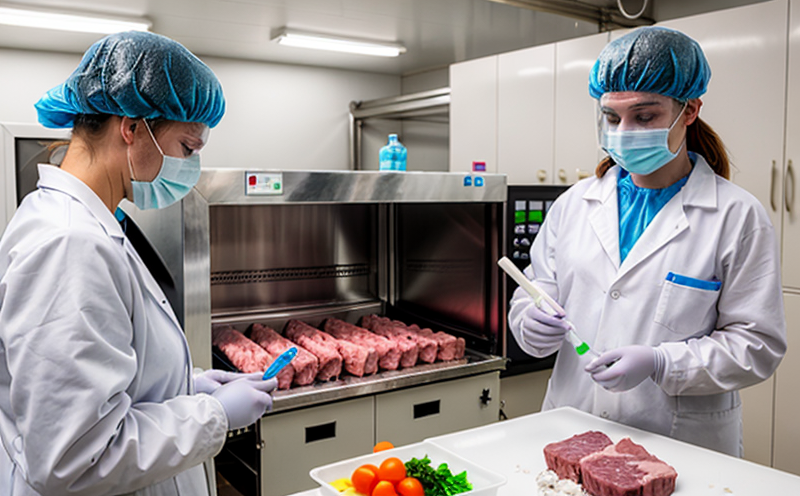AOAC 2014.02 Cronobacter spp. Rapid Detection in Dairy
The AOAC Official Method 2014.02 provides a rapid and reliable means to detect Cronobacter spp., particularly Cronobacter sakazakii and Cronobacter malonosalter, in dairy products. This method is crucial for ensuring the safety of infant formula, powdered milk, and other processed dairy goods that are often consumed by vulnerable populations such as infants.
The presence of Cronobacter spp. can lead to severe infections and even be fatal in newborns and premature babies. Therefore, regulatory bodies like the World Health Organization (WHO), the European Food Safety Authority (EFSA), and various national food safety agencies mandate stringent testing protocols for Cronobacter spp. in dairy products.
The AOAC 2014.02 method involves a series of steps that include sample collection, preparation, inoculation, incubation, and detection using a rapid test kit. This ensures the accurate identification of Cronobacter spp. within a short time frame, typically less than 7 days from sample receipt to result.
The rapid nature of this method is particularly beneficial for quality assurance teams in dairy manufacturing plants. It allows them to quickly identify potential contamination issues and take corrective actions promptly, thereby minimizing the risk of product recall or consumer harm.
Compliance with this standard is not only a legal requirement but also enhances brand reputation by demonstrating commitment to public health and safety. Manufacturers who adhere to such rigorous testing protocols are better positioned in the market, as they can ensure their products meet stringent regulatory standards and customer expectations.
The use of AOAC 2014.02 supports the broader goal of microbiological quality control in dairy processing. By integrating this method into routine testing procedures, companies can establish a robust food safety program that adheres to international norms such as ISO 22000 and HACCP principles.
Given the critical nature of Cronobacter spp., understanding the nuances of the AOAC 2014.02 method is essential for those involved in dairy product manufacturing, quality assurance, and regulatory compliance. This knowledge enables stakeholders to make informed decisions that contribute to the overall safety and integrity of their products.
- Sample Collection: Proper collection methods are crucial to ensure accurate test results. Samples should be collected from various points in the production process where contamination risks are highest.
- Inoculation: Accurate inoculation of samples into the rapid test kit is essential for reliable detection. Inexperienced operators may lead to false positives or negatives, which can have serious consequences.
- Incubation Time: The incubation period must be strictly adhered to as per the method’s specifications. Deviations can result in missed detections or premature conclusions.
- Detection Criteria: Clear criteria for interpreting test results are necessary to avoid misinterpretations and ensure consistent quality control.
Scope and Methodology
The AOAC 2014.02 method is designed for the detection of Cronobacter spp., specifically Cronobacter sakazakii and Cronobacter malonosalter, in dairy products. This includes infant formulas, powdered milk, whey proteins, and other processed dairy ingredients.
The methodology involves a series of steps that are critical for accurate detection:
- Sample Preparation: Samples should be prepared according to standard procedures to ensure they are suitable for inoculation into the rapid test kit.
- Inoculation: The prepared samples need to be inoculated into the provided rapid test kit. This step is crucial as it determines whether Cronobacter spp. are present in significant quantities.
- Incubation: Samples should undergo a specific incubation period, typically 48 hours, under controlled conditions to allow for optimal growth of any present microorganisms.
- Detection: The test kit is used to detect the presence and concentration of Cronobacter spp. Positive results indicate contamination, while negative results suggest that the product meets safety standards.
The method also includes specific acceptance criteria for both positive and negative results. These criteria are based on international standards such as ISO 22079:2016, which provides guidelines for the detection of Cronobacter spp. in dairy products.
Eurolab Advantages
Eurolab offers unparalleled expertise and comprehensive services in microbiological testing, including AOAC 2014.02 for the rapid detection of Cronobacter spp. in dairy products.
- Comprehensive Expertise: Our team comprises highly qualified professionals with extensive experience in food safety and quality assurance.
- State-of-the-Art Facilities: Eurolab is equipped with cutting-edge laboratories that adhere to international standards, ensuring accurate and reliable results.
- Regulatory Compliance: We stay updated on the latest regulatory requirements and guidelines, ensuring our clients meet all necessary compliance criteria.
- Rapid Turnaround Times: Our efficient processes allow for quick turnaround times without compromising quality or accuracy.
Eurolab’s commitment to excellence and customer satisfaction is reflected in the consistent high-quality results we provide. Whether you are a manufacturer, distributor, or regulatory body, Eurolab offers unparalleled expertise and support to help you meet your testing needs effectively and efficiently.





